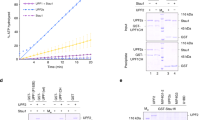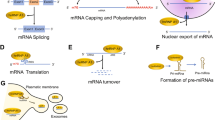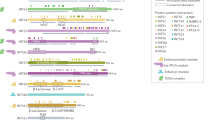Abstract
Metastasis-associated lung adenocarcinoma transcript 1 (MALAT1) is a highly abundant nuclear long noncoding RNA that promotes malignancy. A 3′-stem-loop structure is predicted to confer stability by engaging a downstream A-rich tract in a triple helix, similar to the expression and nuclear retention element (ENE) from the KSHV polyadenylated nuclear RNA. The 3.1-Å-resolution crystal structure of the human MALAT1 ENE and A-rich tract reveals a bipartite triple helix containing stacks of five and four U•A-U triples separated by a C+•G-C triplet and C-G doublet, extended by two A-minor interactions. In vivo decay assays indicate that this blunt-ended triple helix, with the 3′ nucleotide in a U•A-U triple, inhibits rapid nuclear RNA decay. Interruption of the triple helix by the C-G doublet induces a 'helical reset' that explains why triple-helical stacks longer than six do not occur in nature.
This is a preview of subscription content, access via your institution
Access options
Subscribe to this journal
Receive 12 print issues and online access
$189.00 per year
only $15.75 per issue
Buy this article
- Purchase on Springer Link
- Instant access to full article PDF
Prices may be subject to local taxes which are calculated during checkout






Similar content being viewed by others
Accession codes
References
Qiu, M.T., Hu, J.W., Yin, R. & Xu, L. Long noncoding RNA: an emerging paradigm of cancer research. Tumour Biol. 34, 613–620 (2013).
Batista, P.J. & Chang, H.Y. Long noncoding RNAs: cellular address codes in development and disease. Cell 152, 1298–1307 (2013).
Gutschner, T., Hammerle, M. & Diederichs, S. MALAT1: a paradigm for long noncoding RNA function in cancer. J. Mol. Med. (Berl) 91, 791–801 (2013).
Schmidt, L.H. et al. The long noncoding MALAT-1 RNA indicates a poor prognosis in non-small cell lung cancer and induces migration and tumor growth. J. Thorac. Oncol. 6, 1984–1992 (2011).
Xu, C., Yang, M., Tian, J., Wang, X. & Li, Z. MALAT-1: a long non-coding RNA and its important 3′ end functional motif in colorectal cancer metastasis. Int. J. Oncol. 39, 169–175 (2011).
Feng, J. et al. Expression of long non-coding ribonucleic acid metastasis-associated lung adenocarcinoma transcript-1 is correlated with progress and apoptosis of laryngeal squamous cell carcinoma. Head Neck Oncol. 4, 46 (2012).
Ying, L. et al. Upregulated MALAT-1 contributes to bladder cancer cell migration by inducing epithelial-to-mesenchymal transition. Mol. Biosyst. 8, 2289–2294 (2012).
Gutschner, T. et al. The noncoding RNA MALAT1 is a critical regulator of the metastasis phenotype of lung cancer cells. Cancer Res. 73, 1180–1189 (2013).
Friedel, C.C., Dolken, L., Ruzsics, Z., Koszinowski, U.H. & Zimmer, R. Conserved principles of mammalian transcriptional regulation revealed by RNA half-life. Nucleic Acids Res. 37, e115 (2009).
Wilusz, J.E., Freier, S.M. & Spector, D.L. 3′ end processing of a long nuclear-retained noncoding RNA yields a tRNA-like cytoplasmic RNA. Cell 135, 919–932 (2008).
Brown, J.A., Valenstein, M.L., Yario, T.A., Tycowski, K.T. & Steitz, J.A. Formation of triple-helical structures by the 3′-end sequences of MALAT1 and MENβ noncoding RNAs. Proc. Natl. Acad. Sci. USA 109, 19202–19207 (2012).
Wilusz, J.E. et al. A triple helix stabilizes the 3′ ends of long noncoding RNAs that lack poly(A) tails. Genes Dev. 26, 2392–2407 (2012).
Conrad, N.K. & Steitz, J.A.A. Kaposi's sarcoma virus RNA element that increases the nuclear abundance of intronless transcripts. EMBO J. 24, 1831–1841 (2005).
Tycowski, K.T., Shu, M.D., Borah, S., Shi, M. & Steitz, J.A. Conservation of a triple-helix-forming RNA stability element in noncoding and genomic RNAs of diverse viruses. Cell Reports 2, 26–32 (2012).
Conrad, N.K., Mili, S., Marshall, E.L., Shu, M.D. & Steitz, J.A. Identification of a rapid mammalian deadenylation-dependent decay pathway and its inhibition by a viral RNA element. Mol. Cell 24, 943–953 (2006).
Conrad, N.K., Shu, M.D., Uyhazi, K.E. & Steitz, J.A. Mutational analysis of a viral RNA element that counteracts rapid RNA decay by interaction with the polyadenylate tail. Proc. Natl. Acad. Sci. USA 104, 10412–10417 (2007).
Mitton-Fry, R.M., DeGregorio, S.J., Wang, J., Steitz, T.A. & Steitz, J.A. Poly(A) tail recognition by a viral RNA element through assembly of a triple helix. Science 330, 1244–1247 (2010).
Roberts, R.W. & Crothers, D.M. Stability and properties of double and triple helices: dramatic effects of RNA or DNA backbone composition. Science 258, 1463–1466 (1992).
Holland, J.A. & Hoffman, D.W. Structural features and stability of an RNA triple helix in solution. Nucleic Acids Res. 24, 2841–2848 (1996).
Conrad, N.K. The emerging role of triple helices in RNA biology. Wiley Interdiscip. Rev. RNA 5, 15–29 (2014).
Kiessling, L.L., Griffin, L.C. & Dervan, P.B. Flanking sequence effects within the pyrimidine triple-helix motif characterized by affinity cleaving. Biochemistry 31, 2829–2834 (1992).
Jayasena, S.D. & Johnston, B.H. Oligonucleotide-directed triple helix formation at adjacent oligopurine and oligopyrimidine DNA tracts by alternate strand recognition. Nucleic Acids Res. 20, 5279–5288 (1992).
Völker, J. & Klump, H.H. Electrostatic effects in DNA triple helices. Biochemistry 33, 13502–13508 (1994).
Roberts, R.W. & Crothers, D.M. Prediction of the stability of DNA triplexes. Proc. Natl. Acad. Sci. USA 93, 4320–4325 (1996).
Leitner, D. & Weisz, K. Sequence-dependent stability of intramolecular DNA triple helices. J. Biomol. Struct. Dyn. 17, 993–1000 (2000).
Henriksson, N., Nilsson, P., Wu, M., Song, H. & Virtanen, A. Recognition of adenosine residues by the active site of poly(A)-specific ribonuclease. J. Biol. Chem. 285, 163–170 (2010).
Viswanathan, P., Chen, J., Chiang, Y.C. & Denis, C.L. Identification of multiple RNA features that influence CCR4 deadenylation activity. J. Biol. Chem. 278, 14949–14955 (2003).
Plum, G.E. & Breslauer, K.J. Thermodynamics of an intramolecular DNA triple helix: a calorimetric and spectroscopic study of the pH and salt dependence of thermally induced structural transitions. J. Mol. Biol. 248, 679–695 (1995).
Asensio, J.L., Lane, A.N., Dhesi, J., Bergqvist, S. & Brown, T. The contribution of cytosine protonation to the stability of parallel DNA triple helices. J. Mol. Biol. 275, 811–822 (1998).
Leitner, D., Schroder, W. & Weisz, K. Influence of sequence-dependent cytosine protonation and methylation on DNA triplex stability. Biochemistry 39, 5886–5892 (2000).
Cash, D.D. et al. Pyrimidine motif triple helix in the Kluyveromyces lactis telomerase RNA pseudoknot is essential for function in vivo. Proc. Natl. Acad. Sci. USA 110, 10970–10975 (2013).
Gilbert, S.D., Rambo, R.P., Van Tyne, D. & Batey, R.T. Structure of the SAM-II riboswitch bound to S-adenosylmethionine. Nat. Struct. Mol. Biol. 15, 177–182 (2008).
Liberman, J.A., Salim, M., Krucinska, J. & Wedekind, J.E. Structure of a class II preQ1 riboswitch reveals ligand recognition by a new fold. Nat. Chem. Biol. 9, 353–355 (2013).
Theimer, C.A., Blois, C.A. & Feigon, J. Structure of the human telomerase RNA pseudoknot reveals conserved tertiary interactions essential for function. Mol. Cell 17, 671–682 (2005).
Rhee, S., Han, Z., Liu, K., Miles, H.T. & Davies, D.R. Structure of a triple helical DNA with a triplex-duplex junction. Biochemistry 38, 16810–16815 (1999).
Paoloni-Giacobino, A., Rossier, C., Papasavvas, M.P. & Antonarakis, S.E. Frequency of replication/transcription errors in (A)/(T) runs of human genes. Hum. Genet. 109, 40–47 (2001).
Felsenfeld, G., Davies, D.R. & Rich, A. Formation of a 3-stranded polynucleotide molecule. J. Am. Chem. Soc. 79, 2023–2024 (1957).
Felsenfeld, G. & Rich, A. Studies on the formation of two- and three-stranded polyribonucleotides. Biochim. Biophys. Acta 26, 457–468 (1957).
Leontis, N.B. & Westhof, E. Geometric nomenclature and classification of RNA base pairs. RNA 7, 499–512 (2001).
Nissen, P., Ippolito, J.A., Ban, N., Moore, P.B. & Steitz, T.A. RNA tertiary interactions in the large ribosomal subunit: the A-minor motif. Proc. Natl. Acad. Sci. USA 98, 4899–4903 (2001).
Tripathi, V. et al. The nuclear-retained noncoding RNA MALAT1 regulates alternative splicing by modulating SR splicing factor phosphorylation. Mol. Cell 39, 925–938 (2010).
Walker, S.C., Avis, J.M. & Conn, G.L. General plasmids for producing RNA in vitro transcripts with homogeneous ends. Nucleic Acids Res. 31, e82 (2003).
Lykke-Andersen, J., Shu, M.D. & Steitz, J.A. Human Upf proteins target an mRNA for nonsense-mediated decay when bound downstream of a termination codon. Cell 103, 1121–1131 (2000).
Kabsch, W. Xds. Acta Crystallogr. D Biol. Crystallogr. 66, 125–132 (2010).
Sheldrick, G.M. Experimental phasing with SHELXC/D/E: combining chain tracing with density modification. Acta Crystallogr. D Biol. Crystallogr. 66, 479–485 (2010).
Winn, M.D. et al. Overview of the CCP4 suite and current developments. Acta Crystallogr. D Biol. Crystallogr. 67, 235–242 (2011).
DeLaBarre, B. & Brunger, A.T. Considerations for the refinement of low-resolution crystal structures. Acta Crystallogr. D Biol. Crystallogr. 62, 923–932 (2006).
Cowtan, K. DM: an automated procedure for phase improvement by density modification. Joint CCP4 and ESF-EACBM newsletter on Protein Crystallography 31, 34–38 (1994).
Emsley, P. & Cowtan, K. Coot: model-building tools for molecular graphics. Acta Crystallogr. D Biol. Crystallogr. 60, 2126–2132 (2004).
Vagin, A.A. et al. REFMAC5 dictionary: organization of prior chemical knowledge and guidelines for its use. Acta Crystallogr. D Biol. Crystallogr. 60, 2184–2195 (2004).
Acknowledgements
We are grateful for staff assistance at Advanced Photon Source beamline 24-ID and National Synchrotron Light Source beamline X-25, plasmids from K. Prasanth (University of Illinois, Urbana-Champaign, pSV40-mMALAT1) and A. Alexandrov (Yale University, AVA2136) and iridium (III) hexamine trichloride from S. Strobel (Yale University). We thank P. Moore, K. Tycowski and J. Withers for critical review of the manuscript, A. Miccinello for editorial work and all Steitz-laboratory members for thoughtful discussions. This work was supported by US National Institutes of Health grants GM026154 (J.A.S.) and GM022778 (T.A.S.), a Postdoctoral Fellowship (grant 122267-PF-12-077-01-RMC) from the American Cancer Society (J.A.B.) and the Steitz Center for Structural Biology, Gwangju Institute of Science and Technology, Republic of Korea (J.W.). J.A.S. and T.A.S. are supported as investigators of the Howard Hughes Medical Institute.
Author information
Authors and Affiliations
Contributions
J.A.B. and J.A.S. designed research; J.A.B., D.B., M.L.V. and T.A.Y. performed research; J.A.B., D.B. and J.W. analyzed data; T.A.S. and J.A.S. oversaw research; J.A.B. and J.A.S. wrote the paper; and all authors discussed the results and commented on the manuscript.
Corresponding author
Ethics declarations
Competing interests
The authors declare no competing financial interests.
Integrated supplementary information
Supplementary Figure 1 Overview of crystal structures for the oligo(A)-bound ENE cores from KSHV PAN and MALAT1 RNAs.
(a) A schematic diagram (left) is shown for the KSHV PAN ENE core in complex with oligo A9 next to the cartoon representation of the corresponding crystal structure (right)1. ENE nucleotides and oligo A9 are colored green and purple, respectively. Non-native sequence is colored gray. Specific types of hydrogen-bonding interactions are as defined in Figure 1a. (b) Identical to panel (a) except the schematic and crystal structure are for the MALAT1 ENE+A core.
Supplementary Figure 2 Composition and arrangement of three RNA molecules in the asymmetric unit.
(a) The asymmetric unit contains three molecules of the MALAT1 ENE+A core RNA, which are labeled molecule A (green), B (orange) and C (blue) with the A-rich tract (purple for A, teal for B and red for C). Crystal-packing interactions are denoted by arrows and briefly described. The visible 5′ and 3′ ends are labeled. (b) Superposition of the three NCS-related molecules shows that the greatest structural deviations occur in stem I (R.m.s. deviation values relative to molecule A were 5.25 and 2.90 Å for B and C, respectively) and the linker region, while the triple helix (R.m.s. deviation values relative to molecule A were 0.76 and 0.96 Å for B and C, respectively) and stem II (R.m.s. deviation values relative to molecule A were 0.61 and 0.92 Å for B and C, respectively) are more similar.
Supplementary Figure 3 Experimental electron density maps and final refined maps.
(a) Experimental maps generated by MAD heavy-atom phasing using ShelX (1.5 σ) superimposed on the final models (sticks) for molecules A (left), B (middle) and C (right). The ENE (green for A, orange for B and blue for C) and A-rich tract (purple for A, teal for B and red for C) are colored sticks. Nucleotides are labeled according to the positions in the MALAT1 ENE+A core schematic in Figure 1a. This view is a closeup of nucleotides in the three different strands of the triple helix: Hoogsteen (U11, C12, U13, U14), Watson (A70, G71, C72, A73) and Crick (C42, U43). (b) Improved experimental maps using density modification and heavy-atom refinement methods (2.0 σ) for the same region in (a). (c) Final 2Fobs-Fcalc electron density maps using calculated phases (1.5 σ), where Fobs and Fcalc denote the observed and calculated amplitudes, respectively. Region is same as described in (a).
Supplementary Figure 4 A-minor interactions observed in MALAT1 ENE+A core crystal structure.
(a) Schematic diagram of the MALAT1 ENE+A core RNA with the boxed region indicating the A-minor interactions. Hydrogen-bonding interactions are as defined in Figure 1a. (b) Cartoon representation of the two A-minor interactions involving A65 (purple) with G6-C50 (green) and A64 (purple) with G5-C51 (green). Hydrogen bonds for the A-minor interactions are dark blue dashed lines while Watson-Crick hydrogen bonds are light blue dashed lines.
Supplementary Figure 5 Plots of major- and minor-groove widths observed in the MALAT1 ENE+A core crystal structure.
Major-groove (a) and minor-groove (b) widths between the Watson and Crick strands (W-C, black line) and between the Hoogsteen and Crick strands (red line, H-C) are shown. Phosphate-to-phosphate distances are in gray dashed lines for ideal A-form dsRNA and ideal B-form dsDNA created by Coot2. Distances were obtained by measuring direct phosphate-to-phosphate distances by base-pair step. The steps for the major and minor grooves are Pn to Pn+4 and Pn to Pn+3, respectively, starting with the terminal G-U base pair of stem I. A complete list of distances for each phosphate pair is in Supplementary Table 4.
Supplementary Figure 6 ENE+A triplexes are structurally different from other RNA triplexes.
Various RNA triplexes (Hoogsteen and Crick strands in orange and Watson strand in blue) were superimposed onto the phosphate-ribose atoms of the MALAT1 ENE+A core using U•A-U(2-4) (Hoogsteen and Crick strands in green and Watson strand in purple). RNA triplexes include (a) U•A-U(2-4) from the KSHV PAN ENE core+A9 structure (PDB ID 3P22), (b) C•PreQ1-U/U•A-U(1-2) from the PreQ1-II riboswitch structure (PDB ID 4JF2), (c) U•U•SAM/U•A-U(1-2) from the SAM-II riboswitch structure (PDB ID 2QWY), (d) U•A-U(1-3) from the human telomerase structure (PDB ID 1YMO) and (e) U•A-U(2-4) from the K. lactis telomerase structure (PDB ID 2M8K). Nucleotides are labeled in the Watson, Crick and Hoogsteen strands. These overlays correspond to Supplementary Table 6.
Supplementary information
Supplementary Text and Figures
Supplementary Figures 1–7 and Supplementary Tables 1–6. (PDF 2415 kb)
Rights and permissions
About this article
Cite this article
Brown, J., Bulkley, D., Wang, J. et al. Structural insights into the stabilization of MALAT1 noncoding RNA by a bipartite triple helix. Nat Struct Mol Biol 21, 633–640 (2014). https://doi.org/10.1038/nsmb.2844
Received:
Accepted:
Published:
Issue Date:
DOI: https://doi.org/10.1038/nsmb.2844
This article is cited by
-
Deep Conservation and Unexpected Evolutionary History of Neighboring lncRNAs MALAT1 and NEAT1
Journal of Molecular Evolution (2024)
-
The roles of N6-methyladenosine and its target regulatory noncoding RNAs in tumors: classification, mechanisms, and potential therapeutic implications
Experimental & Molecular Medicine (2023)
-
Designing strategies of small-molecule compounds for modulating non-coding RNAs in cancer therapy
Journal of Hematology & Oncology (2022)
-
Engineered pegRNAs improve prime editing efficiency
Nature Biotechnology (2022)
-
PERSIST platform provides programmable RNA regulation using CRISPR endoRNases
Nature Communications (2022)



